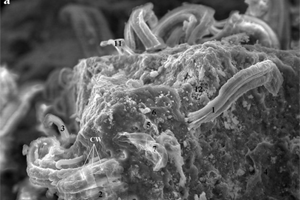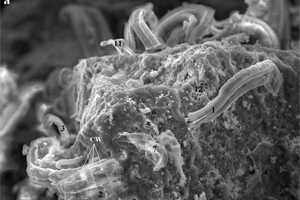 Scanning electron microscope image of the Orgueil meteorite.
Scanning electron microscope image of the Orgueil meteorite.
Credit: Dr. Richard Hoover/Journal of Cosmology
The recent publication of the investigation of a rare class of meteorite (the CI1 Carbonaceous Chondrite) by Dr. Richard Hoover of NASA's Marshall Space Flight Center has caused another stir among scientists and the news media regarding possible origins of life on Earth, and life in the Universe in general. Exciting stuff—though the report stimulated the "usual" spectrum of responses, ranging from the starry-eyed wow! to the cool-headed let's wait and see to a tepid-at-best we've heard this hype before….
In a nutshell, Dr. Hoover's study suggests that encased within the minerals of the studied meteorites are chemical signatures of life and fossils of microbes, some of which are very similar to known Earthly cyanobacteria, and some that are not very like Earth life forms at all. The implication is that life (at least these would-be meteoritic microbes) originated outside of Earth, on some other parent body—possibly a comet—and that the formation of life may be common and ubiquitous in the Universe. It's a very big implication—and as some respondents have cited, big implications require big proof (okay, I'm paraphrasing Carl Sagan's, "extraordinary claims require extraordinary proof").
One of the challenges in this type of investigation is in distinguishing between "indigenous" mineral and microbe-like forms in the meteorites (that is, those that may have come along with the meteorite during its fall to Earth) and contamination by Earthly microbes—because, come on, if the Earth's surface is nothing else, it is absolutely teeming with life in every nook and cranny!
Other implications have been mentioned beside life from "out there" seeding the early Earth and giving rise to us (in fact, there is no definitive proof that life originated on Earth—and according to one theory, life could not have started here).
